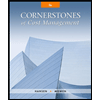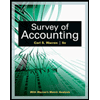
a
Enterprise disclosures: ASC 280 provides guidelines for enterprise wide disclosures in the financial statement to help users to understand risks and potential returns. ASC 280 established the term enterprise wide disclosure standards to provide users more information about the company’s risks. These disclosures are typically made in a footnote to the financial statements.
The segmental disclosure worksheet for C.
a
Answer to Problem 13.14P
Segment profit or loss
| Apparel | Building | Chemical | Furniture | Machinery |
| $110,000 | $155,000 | $(5,000) | $(13,000) | $97,000 |
Explanation of Solution
1. Segment disclosure worksheet.
| Operating Segments | Corporate admin $ | Intersegment eliminations $ | Consolidate $ | ||||||
| Apparel $ | Building $ | Chemical $ | Furniture $ | Machinery $ | Combined $ | ||||
| Revenues: | |||||||||
| Sales: | |||||||||
| Non-affiliate | 870,000 | 750,000 | 55,000 | 95,000 | 180,000 | 1,950,000 | 1,950,000 | ||
| Intersegment. | 5,000 | 15,000 | 140,000 | 160,000 | (160,000) | ||||
| Total revenue | 870,000 | 750,000 | 60,000 | 110,000 | 320,000 | 2,110,000 | (160,000) | 1,950,000 | |
| Expenses: | |||||||||
| Cost of goods sold | (480,000) | (450,000) | (42,000) | (78,000) | (150,000) | (1,200,000) | 160,000 | (1,040,000) | |
| Selling expenses | (160,000) | (40,000) | (10,000) | (20,000) | (30,000) | (260,000) | (260,000) | ||
| Traceable expenses | (40,000) | (30,000) | (6,000) | (12,000) | (18,000) | (106,000) | (106,000) | ||
| Allocated expenses | (80,000) | (75,000) | (7,000) | (13,000) | (25,000) | (200,000) | (200,000) | ||
| Segment profits | 110,000 | 155,000 | (5,000) | (13,000) | 97,000 | 344,000 | 0 | 344,000 | |
| Unallocated general expenses | (35,000) | (35,000) | (35,000) | ||||||
| Income before tax | 110,000 | 155,000 | (5,000) | (13,000) | 97,000 | (35,000) | 309,000 | 0 | 309,000 |
| Assets: | |||||||||
| Segments | 610,000 | 560,000 | 80,000 | 90,000 | 140,000 | 1,480,000 | 1,480,000 | ||
| General corporate | 125,000 | 125,000 | 125,000 | ||||||
| Total Assets | 610,000 | 560,000 | 80,000 | 90,000 | 140,000 | 125,000 | 1,605,000 | 1,605,000 | |
Allocated costs:
b
Enterprise disclosures: ASC 280 provides guidelines for enterprise-wide disclosures in the financial statement to help users to understand risks and potential returns. ASC 280 established the term enterprise-wide disclosure standards to provide users more information about the company’s risks. These disclosures are typically made in a footnote to the financial statements.
The schedule showing which segments are separately reportable.
b
Answer to Problem 13.14P
Only Apparel and Building are separately reportable
Explanation of Solution
Schedule showing reportable segments
Segment is reportable if segment revenue is greater than or equal to 10 percent
| Revenue | Profit | Assets | |||||||
| Segment | $,(000’s) | % | Reportable | $,(000’s) | % | Reportable | $,(000’s) | % | Reportable |
| Apparel | 870 | 45 | Yes | 110 | 32 | Yes | 610 | 41 | Yes |
| Building | 750 | 38 | Yes | 155 | 45 | Yes | 560 | 38 | Yes |
| Chemical | 55 | 3 | No | (5) | -1.5 | No | 80 | 5.4 | No |
| Furniture | 95 | 5 | No | (13) | -4 | No | 90 | 6 | No |
| Machinery | 180 | 9 | No | 97 | 28 | Yes | 140 | 9.5 | No |
| Total | 1,950 | 100 | 344 | 100 | 1,480 | 100 | |||
Therefore, only Apparel and Building are separately reportable.
c
Enterprise disclosures: ASC 280 provides guidelines for enterprise-wide disclosures in the financial statement to help users to understand risks and potential returns. ASC 280 established the term enterprise-wide disclosure standards to provide users more information about the company’s risks. These disclosures are typically made in a footnote to the financial statements.
The information about company’s operations in different industry segments as required by ASC 280.
c
Answer to Problem 13.14P
Segment profit
| Apparel | Building | Machinery | Other | Consolidated |
| $110,000 | $155,000 | $97,000 | $(18,000) | $344,000 |
Explanation of Solution
| Operating Segments | ||||||
| Apparel $ | Building $ | Machinery $ | Other $ | Elimination $ | Consolidated $ | |
| Revenues: | ||||||
| Sales: | ||||||
| Non-affiliate | 870,000 | 750,000 | 180,000 | 150,000 | 1,950,000 | |
| Intersegment. | 140,000 | 20,000 | (160,000) | |||
| Total revenue | 870,000 | 750,000 | 320,000 | 170,000 | (160,000) | 1,950,000 |
| Expenses: | ||||||
| Segment profits | 110,000 | 155,000 | 97,000 | (18,000) | 344,000 | |
| Unallocated general expenses | (35,000) | |||||
| 309,000 | ||||||
| Assets: | ||||||
| Segments | 610,000 | 560,000 | 140,000 | 170,000 | 1,480,000 | |
| General corporate | 125,000 | |||||
| Total Assets | 1,605,000 | |||||
| 60,000 | 50,000 | 25,000 | 21,000 | 156,000 | ||
| Capital expenditure | 20,000 | 30,000 | 15,000 | 0 | 65,000 | |
c
Enterprise disclosures: ASC 280 provides guidelines for enterprise-wide disclosures in the financial statement to help users to understand risks and potential returns. ASC 280 established the term enterprise-wide disclosure standards to provide users more information about the company’s risks. These disclosures are typically made in a footnote to the financial statements.
The information about company’s operations in different industry segments as required by ASC 280.
c
Answer to Problem 13.14P
Apparel, Building and Machinery can be considered as separately reportable, if building segment had $460,000 in assets instead of $560,000 and furniture segment had $190,000 instead of $90,000.
Explanation of Solution
| Revenue | Segment Profit | Segment Assets | |
| Apparel | |||
| Building | |||
| Chemical | |||
| Furniture | |||
| Machinery |
Result of the 10 percent tests to determine if separately reportable:
| Revenue | Profit | Assets | |
| Apparel | Yes | Yes | Yes |
| Building | Yes | Yes | Yes |
| Chemical | No | No | No |
| Furniture | No | No | Yes |
| Machinery | Yes | Yes | No |
Want to see more full solutions like this?
Chapter 13 Solutions
ADV.FIN.ACCT.LL W/CONNECT+PROCTORIO PLUS
- Can you help me solve this general accounting question using valid accounting techniques?arrow_forwardValor Manufacturing, Inc. thinks machine hours is the best activity base for its manufacturing overhead. The estimate of annual overhead costs for its jobs was $900,000. The company used 1,200 hours of processing on Job No. X34 during the period and incurred overhead costs totaling $940,000. The budgeted machine hours for the year totaled 18,000. How much overhead should be applied to Job No. X34?arrow_forwardA forward contract's fair value at inception is typically__. (a) Equal to the notional amount (b) Zero (c) Equal to the premium paid (d) The present value of future cash flows (e) none MCQarrow_forward
- What is the annual depreciation amount?arrow_forwardCan you solve this general accounting problem with appropriate steps and explanations?arrow_forwardDuring 2018, Jacob Industries had sales on account of $945,000, cash sales of $372,000, and collections on account of $782,000. As a result of these transactions, the change in the accounts receivable indicates an increase of how much?arrow_forward
 Managerial AccountingAccountingISBN:9781337912020Author:Carl Warren, Ph.d. Cma William B. TaylerPublisher:South-Western College Pub
Managerial AccountingAccountingISBN:9781337912020Author:Carl Warren, Ph.d. Cma William B. TaylerPublisher:South-Western College Pub Cornerstones of Cost Management (Cornerstones Ser...AccountingISBN:9781305970663Author:Don R. Hansen, Maryanne M. MowenPublisher:Cengage LearningPrinciples of Accounting Volume 2AccountingISBN:9781947172609Author:OpenStaxPublisher:OpenStax College
Cornerstones of Cost Management (Cornerstones Ser...AccountingISBN:9781305970663Author:Don R. Hansen, Maryanne M. MowenPublisher:Cengage LearningPrinciples of Accounting Volume 2AccountingISBN:9781947172609Author:OpenStaxPublisher:OpenStax College Survey of Accounting (Accounting I)AccountingISBN:9781305961883Author:Carl WarrenPublisher:Cengage Learning
Survey of Accounting (Accounting I)AccountingISBN:9781305961883Author:Carl WarrenPublisher:Cengage Learning College Accounting, Chapters 1-27AccountingISBN:9781337794756Author:HEINTZ, James A.Publisher:Cengage Learning,
College Accounting, Chapters 1-27AccountingISBN:9781337794756Author:HEINTZ, James A.Publisher:Cengage Learning, Financial And Managerial AccountingAccountingISBN:9781337902663Author:WARREN, Carl S.Publisher:Cengage Learning,
Financial And Managerial AccountingAccountingISBN:9781337902663Author:WARREN, Carl S.Publisher:Cengage Learning,





